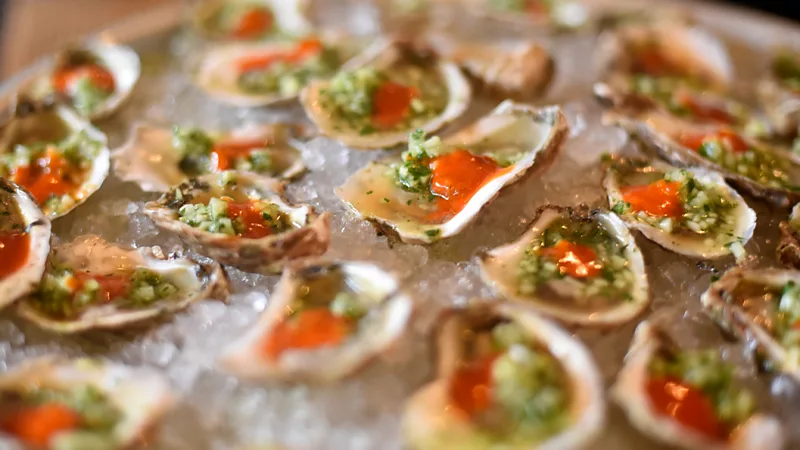Oysters: The luxury delicacy that was once a fast-food fad
As the US leapfrogged through industrialisation, many of its urban workers were fed on a modern delicacy: oysters. How did this shellfish go from fast food to luxury?

Part way through a conversation with Matthew Booker, I realise that when I was a teenager, I lied to a large number of tourists. Please forgive me, visitors to the El Dorado County Historical Museum: I was wrong about the oysters.
Booker, who is an environmental historian at North Carolina State University, is an expert on the filter-feeding shellfish. And one of the most important points he'd like to make about the oyster is that in the 18th and 19th Centuries in Europe and North America, they were incredibly pedestrian. "Oysters were eaten widely as a basic staple," he says. They were a necessary first course for any fancy banquet, true – the 1913 annual dinner of the London Funeral Directors Association featured them prominently – but they were also a cheap protein that anyone could afford, eaten in stews and baked in loaves.
Oysters functioned a bit like eggs do today: an inexpensive protein.
Very readily available, in fact, because, by the 19th Century, they were being grown within American cities. Wild oysters had of course been eaten since time immemorial, as prehistoric middens – or rubbish dumps – full of shells attest. But the size and number of wild North American oysters surprised the first European visitors – Englishman George Percy, who landed in the Chesapeake Bay in 1607, said they were lying "as thick as stones". There was a European oyster species, says Booker. "But that oyster had already become an elite food; it was scarce. It had been hammered too hard… the working class of London didn't eat it anymore."
The real story of the American industrial oyster begins in the mid-to-late 18th Century, he continues. That's when professional oyster growers were mass-producing the creatures by sprinkling baby oysters on the floor of bays and estuaries. "You have entrepreneurs who are specialising in seed harvest," says Booker. The seed oysters could be shipped all over the country by train, before being laid into the water to grow. In 1855, New York State began to lease sections of seabed to individual growers so farms could be formed. Oysters were farmed with such intensity that New York City alone grew 700 million oysters in 1880.
"For a while," New Yorker writer Joseph Mitchell wrote in 1951, "the principal bedders were the richest men in Staten Island. They put their money in waterfront real estate, they named streets after themselves, and they built big, showy wooden mansions. A half-dozen of these mansions still stand… Their fanlights are broken, their shutters swag, and their yards are a tangle of weeds and vines and overturned birdbaths and dead pear trees."
Because, of course, the oyster panics had come.
It was now clear that urban oysters were a health problem
People knew that oysters could make you sick, but the wealthy tried to protect themselves by buying oysters from dealers who claimed to grow in clean water, and the poor by cooking their oysters. In 1854, The New York Times editors looked down smugly on people who were avoiding oysters thanks to a rash of mysterious deaths. "It is a solemn time, when men refuse to eat oysters on invitation," they wrote, and added that despite having eaten oysters recently, they were just fine.
The fact of the matter is, though, that an oyster grown in water where human waste might happen by – and that included the urban oyster beds of the 19th Century – could easily pick up lethal bacteria. Booker describes a tragic case in which a fraternity meal of oysters at Wesleyan College in Connecticut sickened around 22 people with typhoid; six of the young men died. A biology professor performed an investigation, and it soon became clear that the oysters were the culprit.
In 1924, a typhoid epidemic made 1,500 Americans in Chicago, New York, and Washington DC ill; the outbreak was traced to oysters. One hundred and fifty people died, making it deadliest food-borne outbreak in US history, according to periodical Food Safety News. Waters were more polluted than they had been in the past, but also forensic investigation methods were better; it was now clear that urban oysters were a health problem.
Reducing the pollution in New York's harbour could lead to a return of large-scale oyster farming (Credit: Getty Images)
"Peak oyster came around 1910," says Booker. It was all downhill from there.
Oysters are now far from a "common man's" food. And when I was a teenage docent at my county historical museum, telling a local yarn about a gold miner who'd struck it rich, walked into a café, and ordered the most expensive meal he could think of, eggs and bacon and oysters, I told people that the oysters were the priciest thing around. To me, they seemed outlandish, bizarre, the last thing you'd find in a dusty boomtown miles from the ocean.
But Booker says that back in the 1850s they were not nearly as rarified. Indeed, eggs and bacon were probably fairly costly; in the early days of the California goldfields, everything had to be carried from somewhere else.
Now that the water is cleaner, thanks to 20th-Century legislations, could oysters be farmed in cities again? Could they once again provide a relatively sustainable source of protein for city dwellers? There are some efforts to revive oyster reefs as a food source, particularly due to the benefits they bring to coastal habitats.
Booker is skeptical that people could be convinced to imagine urban waters as a clean source of food, but he loves the idea. With the right regulation and thoughtful management, "in great oyster cities, their abundances could well return", he says.
-bbc







